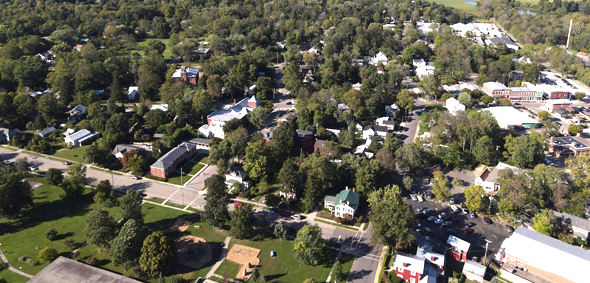
Downtown Yellow Springs and the surrounding neighborhoods, Sept. 2021. (Drone photo by Bryan Cady)
Growing Yellow Springs
- Published: July 3, 2025
How big should Yellow Springs be? How big can it be?
These are questions that have been at the center of villagewide discourse and municipal decision-making for decades — ones expressed in a litany of ways in myriad contexts as Yellow Springs’ population has gone up and down, housing developers come and go, businesses open and close.
They’re also questions Village Council members and Village staff addressed head-on at a recent work session, Monday, June 23, when the group mused over the practical limits of growing the physical boundaries of Yellow Springs, as well as the population within.
Council Vice President Gavin DeVore Leonard said at the outset of the work session that the goal was to look at “the big picture,” as he described it, and for the elected body and staff to talk about ongoing and forthcoming developments holistically and all at once.
Among those projects set to grow Yellow Springs are the forthcoming annexations of two separate pieces of farmland, that combined would expand municipal boundaries by a total of 112 acres; the ongoing development of the 89-unit Spring Meadows subdivision; Home, Inc’s 32-unit, senior-focused Cascades development; and the proposed apartment complexes on or near Antioch College’s campus, which, if completed, would add nearly 150 more rental units to the local stock.
Bearing in mind these still-moving pieces, Council members discussed their priorities and concerns related to growing Yellow Springs, as well as their vision for the future.
“I’m not interested in growth for growth’s sake,” DeVore Leonard said. “How can we share the benefits of this great community with as many people as possible? How can we make it more affordable so we can share our prosperity?”
He added that he wouldn’t support any further growth in Yellow Springs if those efforts weren’t focused on lowering the median age, increasing affordability and bolstering racial diversity.
According to 2020 census data, of Yellow Springs’ population of 3,655, the median age is 53.6 years old, 18% is nonwhite and the median value of owner-occupied homes is $279,700.
Council member Carmen Brown agreed with DeVore Leonard’s priorities and added, “Everyone always thinks about diversity as racial or ethnic, but not socioeconomic diversity. We need more safe and affordable housing in this community — workforce housing.”
Council President Kevin Stokes likewise supported growing Yellow Springs, if only to increase the municipal tax base and to “put more butts in seats.”
“Growth doesn’t need to be a bad thing,” Stokes said. “We don’t need to be afraid of becoming a city.”
As the News reported earlier this year, should Yellow Springs ever reach 5,000 residents, it would be reclassified from village to city, per Ohio Revised Code. The closest Yellow Springs ever came to this threshold was at the time of the 1970 census, when there were 4,624 residents.
Council member Brian Housh was in agreement with his colleagues — that the Village should facilitate growth, and by extension, build more workforce housing — but drew a hard line in what that ought to look like.
“I’m done with single-family homes,” he said. “I don’t want to encourage that in any way. I’m looking at this through a lens of mitigating gentrification and affordability — values we’ve talked about for the 12 years I’ve been on Council.”
Housh and others alluded to the Housing Needs Assessment of Yellow Springs — authored in 2018 by Bowen National Research, costing the Village $24,500 — which recommended expanding the local housing market by building 100 subsidized rental units, 80 low-income rental housing units, 70 affordable workforce rental units, 60 market-rate homes, 15 beds in senior care housing, 40 entry-level homes, 30 moderate-income homes, and 120 high-income homes.
While Yellow Springs gained some new residential units in the seven years since the Bowen study, the village still falls short of its recommendations.
Home, Inc., in 2018, built the six-unit Forest Village homes — its first slate of affordable, multi-family rentals — and then in 2021, sponsored the construction of the 12-unit Glen Cottages pocket neighborhood along Xenia Avenue.
The Spring Meadows subdivision’s 89 market-rate homes and the forthcoming Cascades senior rentals have likewise made inroads to meeting the outlined housing recommendations.
Village Manager Johnnie Burns said that, while he supported the findings of the Bowen study, it had some limitations: It didn’t account for expanding needed municipal infrastructure to accommodate the recommended increase in housing, nor the capacity from current Village staff to make it all happen.
Burns later said that his administrative team is again in discussions with Bowen National Research to update the study to account for more current housing needs and market prices — an update Village Planning and Economic Director Meg Leatherman later told the News that would cost around $27,000.
The village manager said that he is also working with AES Corporation, a utility and power generation company and Village partner, to conduct impact studies that would determine the extent to which the Village’s electrical grid could accommodate new residential developments.
The water treatment plant, Burns said, is presently at a third of its capacity; it was engineered to handle 1 million gallons a day, and on average, it takes in 330,000 gallons. As a caveat, Burns said that adding hundreds of homes or apartments could impact water flow, and would potentially spur the Village to erect a third water tower.
Wastewater is a different story, Burns noted. According to him, the Village is between 60 and 70% capacity; should it reach 80%, the Environmental Protection Agency would impose stricter regulations and processing policies.
“So we need slow, smart growth,” Burns told Council members. “As an administration, we’re doing the best we can to keep our heads above water.”
Burns added that moving forward, the Village ought to consider and consult with the Miami Township Trustees and the YS Board of Education regarding growth.
Police Chief Paige Burge’s remarks on future growth were straightforward.
“More people means more [officers] needed and more stuff needed,” Chief Burge said, implying the police department’s need to keep pace with any uptick in population.
Council President Stokes insisted on continuing municipal and intergovernmental discussions around local growth.
“The time to do it is now,” he said. “We need to make efforts to shape or reshape the community, and we need to have a real serious effort right now. The results will be apparent.”
The next Village Council meeting will be held Monday, July 7, at 6 p.m. in Council Chambers on the second floor of the John Bryan Community Center.
The Yellow Springs News encourages respectful discussion of this article.
You must login to post a comment.
Don't have a login? Register for a free YSNews.com account.















No comments yet for this article.